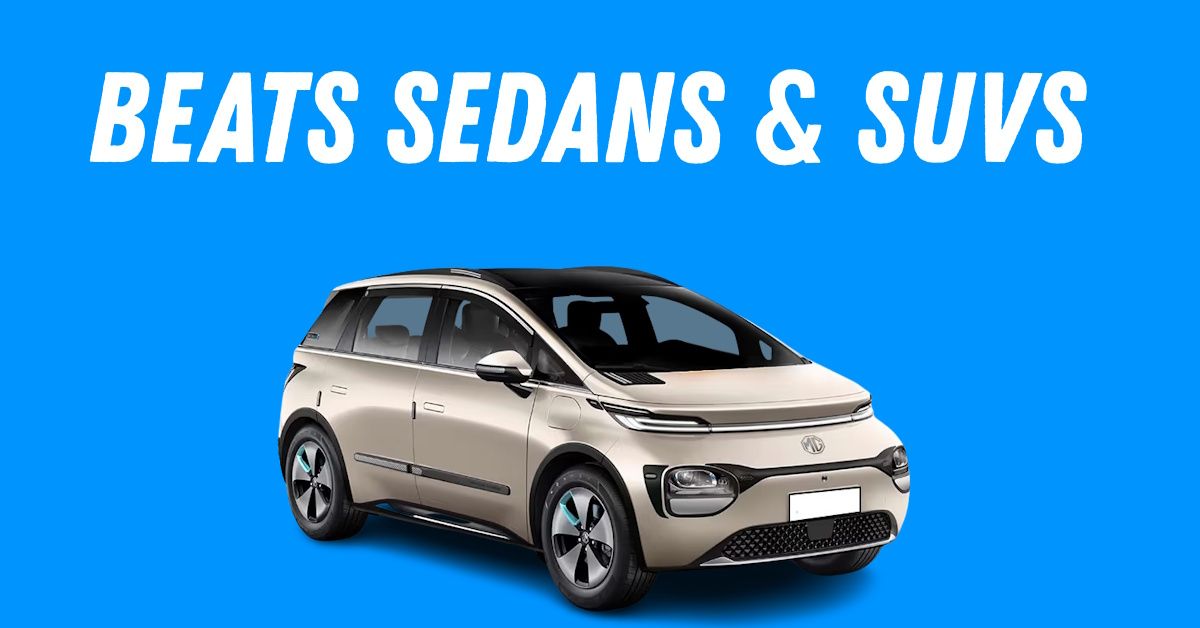MG Windsor EV Now Sells More Than All Sedans And VW Taigun, Honda Elevate, Skoda Kylaq!


JSW MG Motor India’s electric offensive is paying dividends, with the Windsor EV leading the charge. In March 2025, the company reported its highest-ever monthly sales of 5,500 units, marking a 9% year-on-year growth and a staggering 37.4% month-on-month surge. Over 85% of these sales came from electric vehicles (EVs), cementing MG’s position as a frontrunner in India’s EV revolution. The Windsor EV, launched just three months prior, has already crossed 15,000 cumulative sales, setting a new benchmark for electric car adoption in the country.
We have not received exact figures for the sedans (Honda City, VW Virtus, Skoda Slavia, Hyundai Verna) and the SUVs (Honda Elevate, Skoda Kushaq, Volkswagen Taigun) yet but if past months are any indication, they would all be around 2000 or less. And that is an amazing achievement for the MG Windsor.
The Windsor EV’s success has reshaped MG’s sales strategy. Previously reliant on petrol-powered models like the Astor and Gloster, the brand now derives the bulk of its volumes from EVs. Since its launch, the Windsor EV has become India’s best-selling electric car, surpassing the 10,000-unit sales mark in record time. Alongside the Comet EV and ZS EV, MG’s electric lineup contributed to 85% of the brand’s total sales in March 2025. As a result, JSW MG Motor now commands 38% of India’s electric four-wheeler market, second only to Tata Motors, which holds a 46% share. MG has also outpaced new entrants like Hyundai’s Creta Electric, which holds a 20% share in the segment.
The Windsor EV’s appeal lies in its balance of practicality and affordability. With prices ranging from ₹9.99 lakh for the Battery-as-a-Service (BaaS) model to ₹16 lakh for full ownership, it offers a cost advantage over competitors like the Tata Nexon EV, which is priced between ₹18 lakh and ₹20 lakh. The Windsor also boasts a competitive 331 km range and a spacious 604-litre boot, making it a compelling choice for Indian consumers.
MG’s innovative Battery-as-a-Service (BaaS) model has been instrumental in making electric mobility more accessible. By separating the battery cost—typically 40–50% of an EV’s price—the Windsor EV’s upfront cost is significantly reduced to ₹9.99 lakh. Users instead pay ₹3.5 per kilometer for battery usage, offering a flexible and affordable ownership experience.
Currently, 15% of Windsor buyers opt for the BaaS model, a figure expected to rise to 33% as financing options expand. The affordability factor has also led to greater adoption in smaller towns, which now account for 30% of Windsor sales. This shift is attributed to lower acquisition costs and the expansion of charging infrastructure in semi-urban and rural areas.
MG’s aggressive pricing and flexible ownership models have disrupted the electric car segment, posing a significant challenge to competitors. The Windsor EV recorded over 4,675 unit sales in March 2025, outpacing the Tata Nexon EV, which sold around 4,200 units during the same period. Hyundai’s Creta Electric, a relatively new entrant, recorded 2,015 unit sales.
While the Nexon EV retains its position as an established brand, the Windsor EV has gained traction due to its affordability and innovative ownership options. Hyundai’s Creta Electric, despite offering a longer claimed range of 450 km, remains a premium choice, priced between ₹22 lakh and ₹25 lakh. MG’s strategy of providing cost-effective solutions while maintaining competitive range and features has forced rivals to rethink their market approach.
MG is not resting on its laurels. The company is preparing to introduce premium models under its MG Select dealership network, which will expand to 13 cities by late 2025. Among the upcoming launches is the MG Cyberster, an all-electric roadster designed to redefine performance in the EV segment. The Cyberster, featuring a 510 BHP powertrain, 725 Nm of torque, and a 510 km range, will debut in May 2025 as India’s first convertible EV. With scissor doors, a 77 kWh battery, and a 0–100 km/h acceleration time of just 3.2 seconds, it is set to make a strong statement in the luxury EV space. The model is expected to be priced between ₹60 lakh and ₹70 lakh.
Additionally, MG is developing the M9 Electric MPV, a luxury people-mover positioned to compete with the Kia Carnival. This expansion into premium segments signals MG’s intent to cater to both mass-market and high-end consumers.
MG’s strong performance in March 2025 underscores a broader transformation in India’s automotive landscape. The Windsor EV’s affordability and flexible ownership options are driving mass adoption of electric vehicles, while premium offerings like the Cyberster are set to attract enthusiasts. As Maruti Suzuki prepares to enter the EV space with the upcoming e-Vitara, MG’s early-mover advantage—bolstered by innovative pricing strategies—could prove decisive in shaping the market.
For now, the Windsor EV’s record-breaking run sends a clear message: affordability and flexibility are the key drivers of India’s electric future.